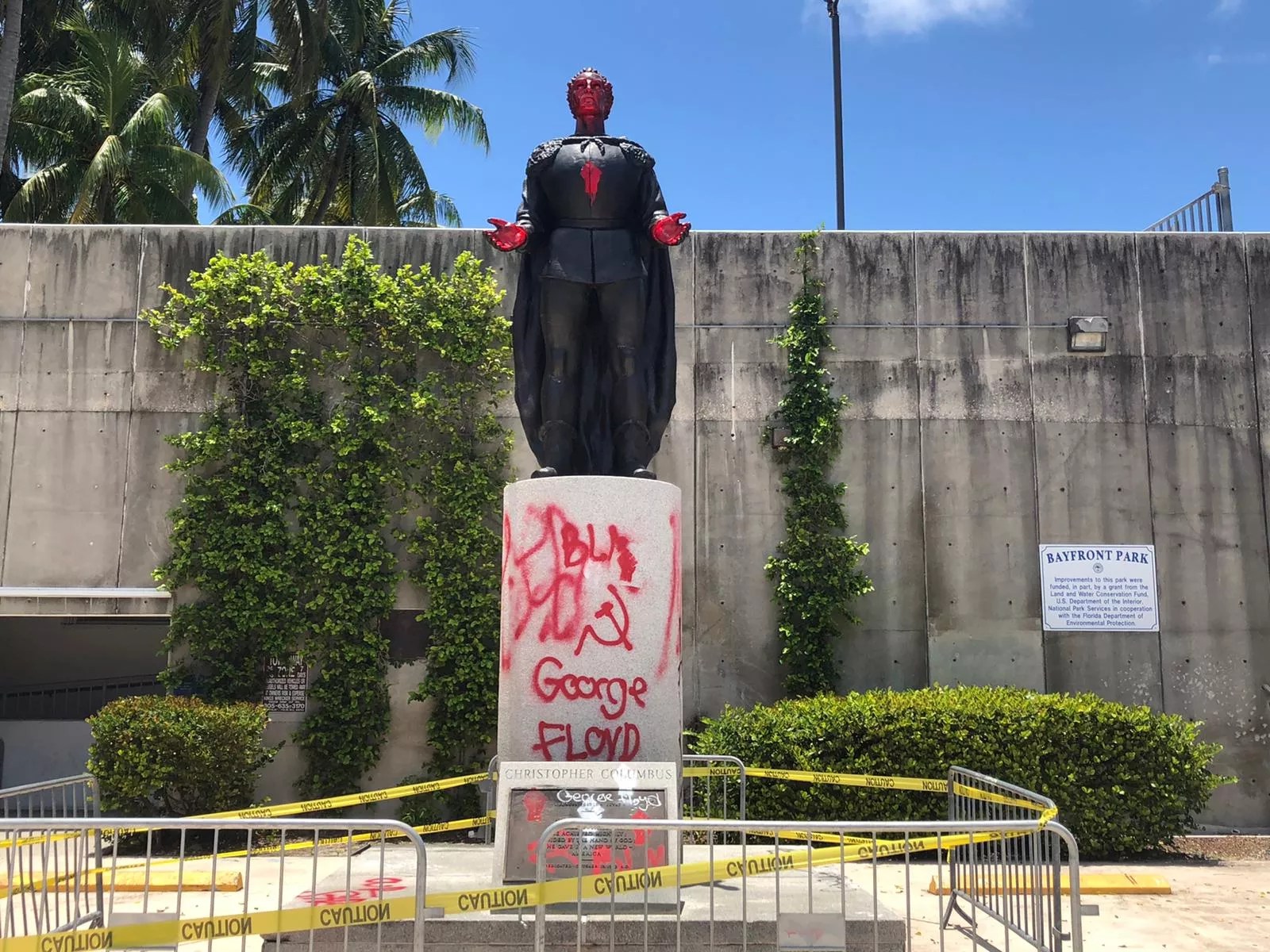
Photo courtesy of Adriana Duprat

Audio By Carbonatix
A Miami bar owner has offered to pay $5,000 to remove a Christopher Columbus statue from Bayfront Park, hoping the city will agree to remove the controversial monument that was vandalized by protesters this week.
Adam Gersten, the owner of Gramps tavern in Wynwood, tells New Times he was scanning Twitter two nights ago and saw videos of police tackling protesters after they spray-painted statues of European colonizers Christopher Columbus and Juan Ponce de León.
“It’s insane… for the police to even need to do anything when the spraypainting red on the statue is so simple and meaningful as an act of expression,” says Gersten. “They literally could’ve gone in an hour after they left and pressure-cleaned it.”
Columbus, in particular, has become a focus of ire from some activist groups because he and his men enslaved indigenous people and infected them with disease.
Gersten says the monument to Columbus is offensive and has no place in Miami. So on Wednesday night, he made a pledge on Twitter that he would put up $5,000 for the City of Miami to remove the statue. He’s hoping someone will match that amount.
Gersten says he contacted someone from the city about the statue Wednesday but did not receive a response. A city spokesperson did not respond to multiple requests for comment from New Times.
I’ll put up $5,000 towards removing the statue and having @CoralMorph place it somewhere as an artificial reef. I’ve already moved a giant statue of a sloth and I can do it again.
— Gramps (@grampswynwood) June 11, 2020
This isn’t the first time Gersten has helped move a statue in Miami. In 2018, he paid to move an enormous sloth statue from the now-closed Miami Museum of Science to a new location by the Miami River.
“I thought to myself, ‘Wait, I’ve done this before,’ and it’s not that hard,” Gersten says.
Gersten offered to have Coral Morphologic, a local environmental group, turn the monument into an artificial reef for Miami’s marine wildlife. But Colin Foord, a co-founder of Coral Morphologic, says the statue doesn’t even deserve that much.
“Putting it underwater still gives it too much credit. Maybe with his head in the sand or face-down in the sand is more appropriate,” Foord tells New Times. “Besides, if it’s made out of bronze, marine life would not grow on it because it’s toxic. Maybe that says something to the toxic nature of Christopher Columbus.”
The vandalism of the statues in Miami comes at a time when protesters around the world are defacing, destroying, or calling for the removal of monuments to controversial figures.
In Bristol, England, demonstrators took down a statue of slave trader Edward Colston and threw it into a nearby harbor, sparking debate over other monuments. In Boston, a Columbus statue was beheaded. The mayor said the city would take time to assess the “historic meaning of this action,” according to CBS News.
Paul George, the resident historian at History Miami, says historians and the public have a different perspective on Columbus in recent decades after many years of revering him as a hero for opening up “the New World” to colonization.
“He enslaved people, and some would argue he opened the gates for an onslaught of disease and onslaught on native people,” George says.
In the 1980s, Miami wanted to be at the forefront of the 500th anniversary of Columbus arriving in the Americas, according to George. But by the date of the anniversary in 1992, there was hardly a celebration.
“Miami had lost interest in being ground zero for the celebration. No one wanted to be ground zero,” he says. “Historians were now looking at history not just through the eyes of generals and presidents, but of different groups and classes and races.”
Miami’s Columbus statue is not even as prominent as it once was. George says it used to be much closer to the front of Bayfront Park, near Biscayne Boulevard. Now, it’s behind the amphitheater and out of the way.
George says the narrative of Ponce de León has also changed in recent decades.
“Ponce de León is held up as a villain in the minds of some because it was his first two visits to Florida in the 1500s that opened the doors to a whole series of would-be conquistadors… to the detriment of native populations who would disappear in later centuries,” George says.